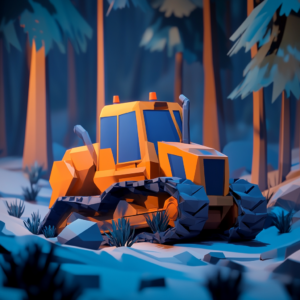Forest operators work alone, often in darkness, operating heavy machinery entirely on their own. When thinning a forest, a machine operator has to decide which trees to fell. −Cognitively, it’s a tough job to analyze and decide which trees to cut, says Lars Svensson, CEO and co-founder of NFA, Nordic Forestry Automation. To make an operator’s job easier, NFA develops tools based on innovative technology that automates parts of the work.
The NFA team finds themselves at the forefront of technological advancements – in the forestry industry. Their goal is to create sustainable and efficient solutions that benefit forest owners, operators – and the environment.
The team develops digital tools and precision forestry solutions based on sensor techniques.
It all started with Lars Svensson’s idea about forestry automation. He’s got a PhD in Robotics from KTH Royal Institute of Technology in Stockholm and an MSc in Engineering Physics from Uppsala University. Lars’ specialty is technology for autonomous vehicles, something he’s spent years developing. At Kungliga Tekniska Högskolan, Volvo, and Scania, he also researched and worked with algorithms for motion planning and control.
When Lars did a research exchange in Berkeley, California, he got enlightened – academically as well as entrepreneurially.
Growing a business started to appeal to me, he says. Halfway through my PhD, I started to get more and more interested in motion planning and control related to forestry/management and began to mull over a few ideas.
Firsthand Forest Experience
Growing up on a farm in Sweden, with family and friends in forestry Lars has tried small-scale forestry himself.
I knew that motion planning and control technologies would develop forestry. I didn’t know how, though. I figured that perhaps there’d be room for a startup working on automating certain parts. It hadn’t quite reached the forestry industry yet, but I knew it would, soon.
The forest is an organic environment. Forests also vary greatly. According to Lars, advanced sensors, algorithms, and software come in handy in forest management.
The so-called perception revolution in AI represents a major milestone in the development of artificial intelligence. It has brought machines closer to human-like perception and understanding of the world around us.
Lars and his team use the same technology used in autonomous vehicles.
Sensors used to be expensive, Lars says. But, with the rapid development, they have plummeted in price. To measure trees robustly and accurately, smart algorithms are useful.
Looking for Problems to Solve
In the early days of NFA, Lars and David Gillsjö, co-founders of NFA, developed a toolbox based on their knowledge of autonomous vehicles and AI.
We wanted to see which challenges we could address using our technology, Lars says. We brainstormed in search of forest issues to take on and that we could address with our tools.
In the search for challenges –they knew they would find some– they got in touch with several large forest companies in Norrland, thanks to the so-called ‘forest technology cluster’.
Looking at their respective value chains, we started investigating to see where sensors, automation, and AI could contribute; Lars explains. Could there be a value in the type of services we were envisioning?
The team got a few interesting suggestions to evaluate.
Understanding a Forest Machine Operator
They found the way forestry machine operators work interesting. Operators drive large, complex machines that kind of becomes extensions of their bodies.
When thinning out the forest, you need to master forestry practices, Lars explains. These involve figuring out how many trees to sort out and which. To make these decisions, operators use intuition and experience.
Thinning means cutting down a subset of trees and not all of them. When thinning, an operator must concentrate and analyze the situation all the time, which is completely different from clear-cutting an entire forest.
It’s up to the operator to assess which trees to take down and which to keep, says Lars, as well as how densely the trees ought to be spaced.
There is a clear and research-based specification that describes how to proceed. It details what density the remaining forest should have. Factors such as age, type of habitat, e.g. play a role.
But the tools that operators use today, require that they get out of their machines to measure, using an optical tool.
It only gives a rough image of a small portion of the forest. It doesn’t offer any further guidance, says Lars. It’s the same tool that’s been used since 1880.
The Missing Piece – an Image
We concluded that tools, based on sensors, could make operators’ work much easier, says Lars.
The NFA team came up with the idea of creating a digital representation of the area around the machine. Having a big picture of the forest would make it easier for operators to plan their work.
The digital representation of the forest surrounding the machine became a fundamental piece of the puzzle, says Lars.
NFA mounts a sensor on the forestry machine, which reads and creates a live image of the surroundings. The image describes the entire area of the forest near the machine.
The digital representation helps the machine operator sift through the forest and get the big picture. Looking at a 3D version of the forest from a screen inside the machine gives the operator an overview that helps select which trees to take down to thin out the forest.
In the next generation, says Lars, you will be able to point out specifically which individual trees to remove.

AI-Generated Image of a Forest Machine for Decoration
Forestry Requires Planning
Every forest needs a management strategy.
When managing a forest, carbon balance and biological diversity also need to be considered, says Lars.
It is well known that clear-cutting forestry practices are harmful to biodiversity. Since many initiatives today focus on carbon sequestration and biodiversity, forestry machine operators also need to implement management methods that can achieve such goals.
Our solution helps the operator implement any strategy. We build tools for all operators to carry out any type of forest management.
According to Lars, the unique feature of the solution is a robust perception functionality* in a forest environment.
It’s the cornerstone of all autonomous systems, he says. Right now, we are working towards partial automation. We envision that much of the management will be fully automated in the near future.
The Next Steps
NFA currently has a few systems in the forest and works with early adopters. Those are customers looking to automate parts of their forestry management.
Currently, we’re developing a pre-series of the sensor solution They are being deployed in the field to initiate a data loop and capture data.
While developing and fine-tuning the solution, the team collects data to improve processes.
The data will also consist of feedback from operators. They’ll help us quantify the customer value, says Lars. We will learn how to better support them.
Data also serves as an added benefit: the collected data also gives customers a forest inventory.
—
*Robust perception functionality in a forest environment means that a system or device can accurately and reliably sense and interpret its surroundings within a forested area. This involves being able to:
- Detect objects: Trees, undergrowth, trails, and potential obstacles.
- Determine distances: The system accurately measures the distance to objects in its environment.
- Recognize patterns: The system identifies specific tree species, recognizes forest types, or detects changes in the environment.
- Handle varying conditions: Works well in different lighting conditions, weather, and terrain types.
Read more


